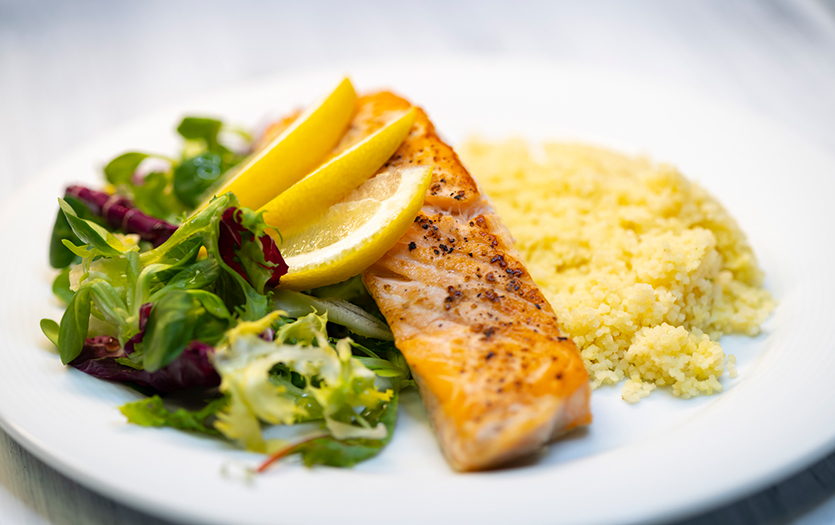
This post was written by Stefanie Raaen, CHWC, Workplace Wellness, Parkview Employer Solutions.
For many of us, life is busy. Whether you work long hours, have small mouths to feed or are balancing hectic family schedules, it’s important to be able to prepare quick and easy meals during the week. One thing that can help you find success is meal planning, which allows you to plan out your menu for the week ahead of time. This simple idea can save you time and money, while making mealtime decisions one less worry.
If this sounds like something you could benefit from, here are some simple steps to get you started.
Use grocery pickup. Although this certainly isn’t a must, it does make things more convenient if you’re strapped for time. Sit down on a Sunday morning, have a cup of coffee, open the app for your favorite grocery store and do all your shopping from the comfort of home. Not only does this save time, it also stops you from the temptation of impulse buying while you’re at the store, and saves you from having to remember if you already have something at home — you can just go look!
- Pro tip: Make a list and stick to it. Shopping through an app gives you a unique opportunity to save money by buying exactly what you need and not picking up things that look/sound good while you’re at the store.
Start with your protein. When it comes to a balanced meal, there are three components you need to think about: a protein, a vegetable and a healthy carbohydrate. The first step is to pick your protein. With heart disease being the number one cause of death in the U.S., it’s important to choose proteins that are healthy for your heart. One to two seafood proteins a week are ideal if you enjoy them. Salmon and tuna are filled with lots of omega-3 fatty acids that help keep good cholesterol high. Lean proteins, such as turkey, chicken, lean ground beef, beans and tofu, are another good choice. Red meats are also okay in moderation.
- Pro tip: Let the discount be your guide! Choose your protein based on which ones are on sale. This will help save you money and is an easy way to add variety to the week.
Add your veggies. Once you have your staple proteins for the week, build the rest of your meals around them, starting with your vegetables. You can always look at which produce is on sale that week or simply choose your family’s favorites. Some delicious vegetables that take 20 minutes or less to prepare include kale, spinach, asparagus, mushrooms, bell peppers, Brussel sprouts, broccoli, squash, zucchini, and the list goes on!
- Pro tip: Worried that you won’t make it through fresh produce in time or don’t want to chop veggies? Canned and frozen vegetables are awesome alternatives. Just be sure to check labels for excess sodium and added ingredients.
Finish up with your carbs. Last but certainly not least, choose a healthy carb to round out the meal. There are so many options depending on what meal you’re having. Your carb could be a side, such as rice, quinoa, couscous or potatoes, or a part of the main dish like whole grain pasta or a whole grain bun for your burger.
- Pro tip: When possible, choose whole grains! They contain more fiber, can help with weight management and may even reduce the risk of heart disease. Look for labels that say whole grain or 100% whole wheat.
Mix up your staples. If you’re afraid your meals could become boring, try adding different seasonings each time you make a recipe. This is a great way to add flavor without adding unnecessary sugar. Try a variety of spices, many, even ones you may not have tried before, taste great and can completely change the flavor of a meal. You can also use citrus fruits such as lemons, limes and oranges to liven up a marinade.
- Pro tip: Store-bought sauces and marinades can be great as well but be sure to check the label for unwanted added sugars. For more on stocking a healthy pantry, check out this post.
Time it up right. Pretty much any meal with the staples listed above can be prepared in just 30-minutes or less. If you’re cooking rice, quinoa or couscous, be sure to start cooking them first. Next, cook your protein—baked, grilled or air-fried are the healthiest options. Once your protein is cooking, start your vegetable. The cook time will depend on which vegetable you’re cooking and how you like it. For example, if you like your Brussel sprouts crispy, you may need to start them right after you begin cooking your protein. If it’s a vegetable that sautés quickly like kale or spinach, you can start this just 5-10 minutes before your protein is done.
- Pro tip: Have a night that is especially busy? Add a precooked rotisserie chicken to the grocery list! Chicken and veggie wraps or tacos in a whole grain tortilla are quick and delicious options.
With a little bit of practice, meal planning can help you take some of the stress and worry out of feeding your family when things are hectic. Scope out your week ahead of time and know which nights you can dedicate more time to cooking and which ones need to be extra quick and easy. By keeping these tools in your back pocket, you can plan for and prepare quick, easy and wallet-friendly dinners every night of the week.
Parkview regularly offers cooking classes with a variety of topics. Follow the calendar of Classes and Events on parkview.com to watch for upcoming opportunities.
Help employees achieve wellness goals
Parkview Employer Solutions partners with area businesses, delivering innovative services to improve the health and well-being of employees. Workplace Wellness provides resources for local businesses to create a healthier workforce, including health risk assessments, wellness coaching, health improvement programs, wellness screenings and more. Contact Parkview Employer Solutions to develop a wellness program that benefits your company, your employees and your community.



